Chapter 1. Chapter 10: Mutations and Cancer
1.1 Introduction


Welcome to the Interactive Study Guide for Chapter 10: Mutations and Cancer. This Study Guide will help you master your understanding of the chapter's Driving Questions, using interactive Infographics and activities, as well as targeted assessment questions. Click "Next" to get started, or select a Driving Question from the drop-down menu to the right.
Fighting Fate:
When cancer runs in the family, ordinary measures are not enough
DRIVING QUESTIONS
- What are mutations and how can they occur?
- How does cancer develop and how can people reduce their risk?
- Why do people with “inherited” cancer often develop cancer at a relatively young age?
1.2 Driving Question 1
Driving Question 1
What are mutations and how can they occur?
Why should you care?
Some mutations may be caused by mistakes made during DNA replication that aren’t repaired by normal cellular mechanisms. Even though such mistakes are very rare during each replication event, replication itself is so frequent that mutations add up over time. Mutations give rise to new alleles – i.e., alternative forms of a gene that can be passed from parent to offspring.
For most women, the risk of developing breast cancer is 12-15% (1 in 7 women). For women with a mutation in the BRCA1 gene, however, the lifetime risk of developing breast cancer is 40-80%. Moreover, the mutation also creates a 20-50% lifetime risk of developing ovarian cancer. The mutation is hereditary and involves only a small change in the normal BRCA1 DNA sequence.
Lorene Ahern inherited her mutated BCRA1 allele from one of her parents. But mutations – including those that increase cancer risk – can be caused in other ways as well. Understanding the causes of mutations can help us make wise lifestyle choices that can reduce our own cancer risks.
What should you know?
To fully answer this Driving Question, you should be able to:
- Compare and contrast the normal BRCA1 allele with the allele that increases the risk of breast and ovarian cancer.
- Illustrate and describe how errors in DNA replication and repair can result in mutations.
- Compare and contrast the three different ways in which DNA mutations may be acquired.
- Predict whether a mutation in the DNA of different parental cells will be inherited by their offspring.
Infographic Focus
The infographics most pertinent to the Driving Question are 10.1, 10.2, 10.3, 10.4 and 10.5.
Question Test Your Vocabulary
Choose the correct term for each of the following definitions:
| Term | Definition |
|---|---|
| BBZUQ8LO98pv/rqwFvHUW32wJUTWBOzdF3Ugjo//o87XPo8jUAirDB/dBe4QBKQtOVzQmxsQ0v3DKEYVoMZkR0spNRMHVjHv | A mutation occurring in gametes; passed on to offspring. |
| H3oSCnFcdmDFpPv0PRQ/NWBVyMyYa3ul8cSDw9JMwd3pXgjWXg1PwzHJv4Fq0dp9Wh6fpKazd8WfF8MdEGw6uVXOIPjxl6aV | Any chemical agent that causes cancer by damaging DNA. Carcinogens are a type of mutagen. |
| YWHjbFu32LtlEqAtTR0L3wmtYplui4Ui6eUMApmaCUJceQ76Etoq2ZSRuYwPgg81g9yuyxUXMZfwkAH9yS9IH7aK2iOz4GOl | Any chemical or physical agent that can damage DNA by changing its nucleotide sequence. |
| 9/wUGq2QlngpvS1QQvlNNCT3ASC6jRyEqmdPHL5Wc8sRy7HJ+CFTrQFvKR2q651dVZedG8at5jRt4GzzxTcwUfFoFFaEo9mt | A change in the nucleotide sequence of DNA. |
| 5ySSJjEMnKIXTnm+nwx1EHpNfhROJuIdEPVpiXuucE0Zoth3huGjOh2BX+yALummMhzaENsHmW89XLu4rGfojSGmDP39hD6C | A mutation that occurs in a body (nongamete) cell; not passed on to offspring. |
Compare and contrast the normal BRCA1 allele with the allele that increases the risk of breast and ovarian cancer.
Question 1.1

Describe how errors in DNA replication and repair can result in mutations.
Question 1.2
i3HZ/4yIMXsfuUZ2JFShMuDGoq/vA9XI06UjP1SzMMzhPbX3CRrqtl3fZwEsjQ/OXa1MdtSTsdMYkeD8m4nhXJASl5TdBi8n8lBhzavffGD1J+xLQ0JdXtyvof8DCrJiLogVETPajoE=Question 1.3
ZoLbwwhcUpd93oh23r7m+UcOj4AoQamLepZBTshotMIuWnfn4vaZ3VHwvzRtM0XC/5PQXKXaFCq2bwCrhA0yNIxHWKN0dfbStciI0HkPOorSvZfFyVL/Eyb0BFXPZ+rB/Tr07+vTF0OpKxLwpZKAevLIlqY5fcHy9saDDoQSzU7fe/MyxQI2jDAnxJ0O8iSHz3o1fQ==Compare and contrast the three different ways in which DNA mutations may arise.
Question 1.4
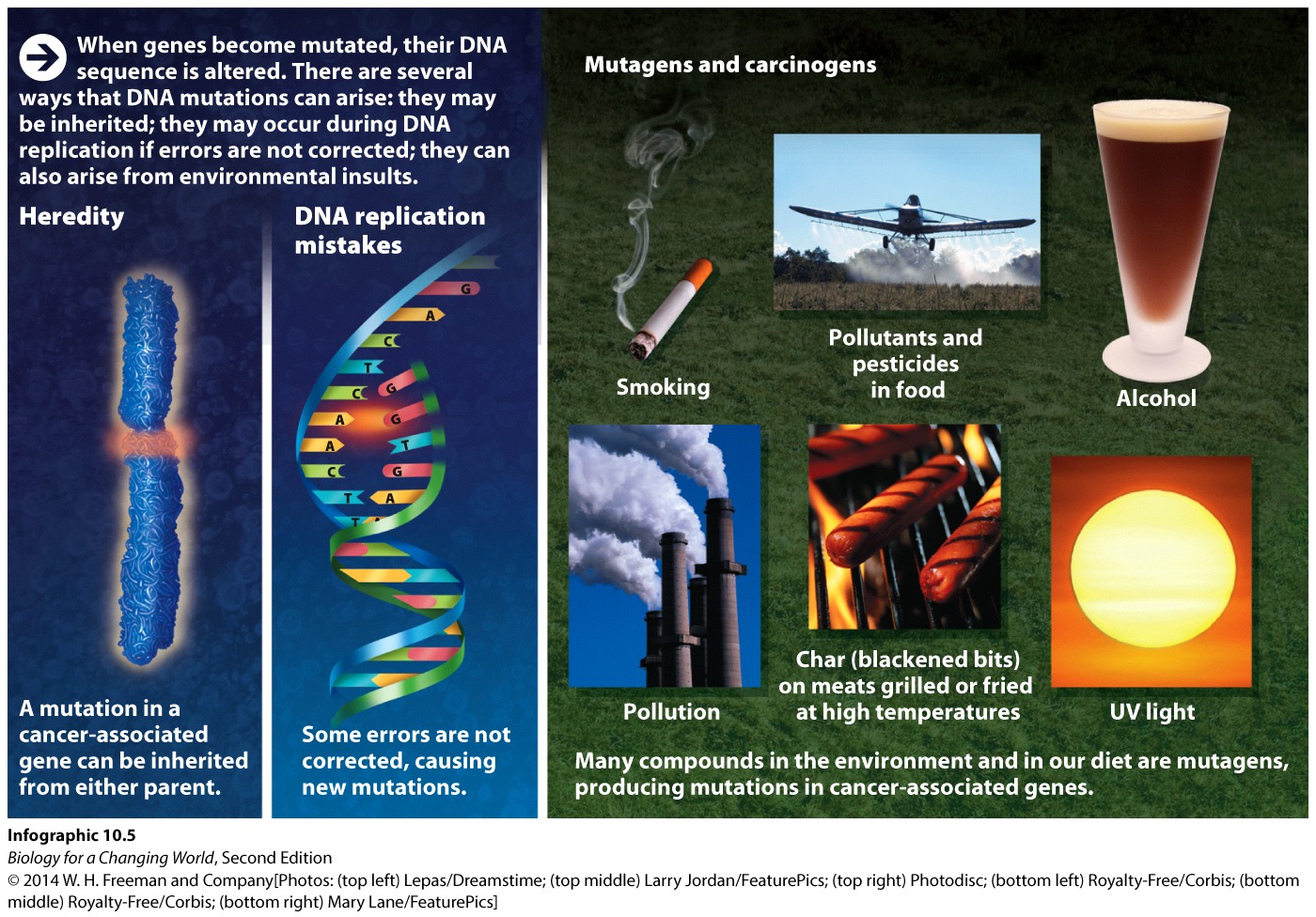
Question 1.5
SBFTWK1T4oecU8uKBIlhOMT7YnGVVt3/wzd+MHwi5OfAybFCfBJi3OB/4DR2e2xWcgnWrblhyeyLNwL3OnYl8Fichxm48X9mTWX4l1EaKyK6xJ5YzSe6NZ/oWsCN0F1WC5S4V/Jh/NyXkYms71o3boouqcC4h7HFJY7JdqUNTluuyYIieRA9yg==Question 1.6
o6NHvFdFv/gun14gDyWqtbl4ELHHWYmbt5PSSFx7S8fr7c9NaF0iuBdt3svMhnpC+GKvSNL9QW2ocxWnxhYOzPfWKC1ET78Ajq+cZDU50Zag7H6arOiB7mxWdWj8Wnp7KiHZkjSLsdw=Predict whether a mutation in the parent DNA will be inherited by their offspring.
Question 1.7
Will a child inherit the following mutations from their parent? Why or why not?
3grEOF/cEOPt4N0emPzGiCCEIr1vks9UYVv8kyoqod0h5//MnJztUwRCgPhhPsP0pYVw1uhMDel/vNjPgGz+Jez6IRtHymQ4C3sM7w==Question 1.8
kxlo++UcIJsgmIFdjKSEBnhIrvnq8XNfF3jZmVqAUtgAFmgwO7M2DglUM22sFxXvO+ahCw494WbXjT6NQuestion 1.9
gH74/8u6gtjF6MV777nXp16axcJwJ56JDRIqvzGSuZ5KHFDHfyPx3r1hhXflejHrDXEbo+GkYtuLXe3maTB9V12JON6LIdQFvJzk56UT5FtU3uewD0WkL9Y41uXIXIF95QknN9YMEi9n5f7atAB8omBRaFetvjpvBn+Rm7BnevwSuzMZZkyB68Z0coczMpdHReview Questions
Question 1.10
Mutations in DNA can be caused by: (mark "true" for all that are correct)
a. Smoking cigarettes 2YvaXR/y8mhoD5Q0hHYKqg==
b. Heredity 2YvaXR/y8mhoD5Q0hHYKqg==
c. UV sun tanning beds 2YvaXR/y8mhoD5Q0hHYKqg==
d. Char 2YvaXR/y8mhoD5Q0hHYKqg==
Question 1.11
True or False: Tumor suppressor genes suppress tumors by pausing the cell cycle so a dividing cell can make repairs. 2YvaXR/y8mhoD5Q0hHYKqg==
Question 1.12
/QVSUapQHGkYGUTcphoSFleb1PFLeMYZ1mzSthkWXuOZFVAkHekJ8PZcDkrhd3lQckAmw+Ara4CHNZzGiHpBiDiy3Aym8NTsbEZYyxSAlITj/SHLsI3AlLjxZhJXnYTh3FSwmoVb+PAn2uPZUlfP5x0ekrlhG55P7Lan6QH0ojc9DhJsGsq9G5cN/Yw8/dBW782sy8Lms6VKZa5dS9flGf4hN0tG3l+Ixd3QUu2Ah6/eCJlGymcOstwV2AJHI9EygPL3CXsBX5wk6l8xuMJySNeiGvOX8ByPaq5Qn7KMPZGqvepyaVc1teN5BTBy1tgwC15T4AXKIp+YdhA9aNJIDyX7ubpw72VjQVSLm+w3Y26WEYR6YphobctCDDR9LwOScGfkD19gvAiNIGmTJXi1LVc5gCoNGjmmvA1NjUAznP9z79I4YtN7JU2AK0XfmQsmCQlFPGtou6c5neFCOgjxspHsX5zQ2UG+CQGd1jGXidSiLSVJf0aiJd442P8mLBFU0BkplfKlqHgWvKzLoo3SaAODWg+HbkW3xearuQWxAxTK4cDjsdXt02yOI4iijLTxWcXutCVtBy9bUKBIWphyUgc58nWKB6ka8CVAaxtEMj5O4sx8nKDjPJH/GaxwfkqvvqA9pRQsxk8=Question 1.13
P33gtRkMddw4CV8e1ZOzpi4w/87PXFiQxYmOyIrX3bpmaZ37HigPte6+zIAA9cuW5k/oozqKULVm1qfYPOhd5eHHD3ysr18BvXD2vUOgskRwRAmeyIshc6O/+5HNAYxRpUev8OvZlMq9WsNXGrZ+6m6fMN9REX2hxSjA1aF0Sd6DqQyAvV+E22YHp5agtxhtQ9f1wFASukMLsBBTzMQIiM3dmbAR/wlgfVwmVT2jJQTwYJWt2utO2JxsWwLzkerflWEa0C4ak0qCKyB78UjXetoG0Py0YFg0sWejC7PQB7PBoJnwNvp0iTZ5nhgS0V06VmmnaJ46WxuIoU6Vk10M3AlJPJuLAsjlHKUsFif36eguY9GgO/20OBL+ko9Zq/HiPOTdp/Yir4ZZHttPDSpKzc0dK4FvPfautcufPFTB2fQ9B39dDzKKQVAR7FDwxMRB/fq09G9KdfBL1f3dkkYGwogAFNHEpTA6cvCMZAK7wmLklpKaEhKA6fQvnI+06VFgpxICVL+yL59XLN6JXwMWw124cFIvCcIRmm5jRAtb/HtUoQwSj+t5hP+4eiU9izh2PFlcg6Icb+bE+30Qe9vxoliNkrlGclyabGJWYCXImS+zLEsvCy++YX15dg9Dffp9OWamqMeSoKs36Qy4CURhFghZUnpmFN69zf1OkA6cvwAVsYf+ix11NCOCpJ3jU4euvbGNVKqIG6Q=1.3 Driving Question 2
Driving Question 2
How does cancer develop and how can people reduce their risk?
Why should you care?
Cancer is a disease caused by problems in the cell cycle control mechanisms. Two types of genes control the frequency and timing of cell division. Proto-oncogenes normally control how often a cell divides (often by responding to external signals that initiate division), while tumor suppressor genes – including BRCA1 – typically slow down cell division, repair damaged DNA, and kill cells whose DNA is irreparably damaged. Lorene Ahern’s mutated BRCA1 allele increases her risk of breast cancer because the protein it produces cannot repair damaged DNA. If enough DNA damage accumulates in a group of cells over time, cancer is a likely result.
What should you know?
To fully answer this Driving Question, you should be able to:
- Illustrate and describe the process by which a mutation can cause cancer.
- Compare and contrast the roles of proto-oncogenes and tumor suppressor genes in regulating the cell cycle.
- Explain how mutations in proto-oncogenes and tumor suppressor genes can increase cancer risk.
- List and explain some ways in which people may reduce their cancer risk.
Infographic Focus
The infographics most pertinent to the Driving Question are 10.3, 10.4, 10.5, 10.6 and 10.7 and Table 10.2.
Question Test Your Vocabulary
Choose the correct term for each of the following definitions:
| Term | Definition |
|---|---|
| BqtvYpvj71SKcXH+Bu/V+OpAovzh6JBMswZup5rxn69w9VaM2bMCO/lOZD9iIjY8hTLzQZaaHY1yTsbmD8NbAGRM2QtvXl4HPvRo+z3yXo5uoICM9NPUVJudxSW2pWFRnCyovprtZBlbS5isDEVhUvvx2Dlb7E8+A+JFrzFLHTlbDcJ5YXKo1MmI4b15fiFE | A gene that codes for proteins that monitor and check cell cycle progression. When these genes mutate, tumor suppressor proteins lose normal function. |
| oLd+wHQHloW6uKVBwNZEHyMcdVm5Yt3Zd4835Y4jMTTyioea+I13P9jTQzM3LTib6IuCIxIsl9ZYj4IyhNA03tYj+Zjho52HsLm9+JWuVDKNBk+d00VCUAFTvb0Y1OyCRdS5+X2Mt6vp/4+hjVpEfmOIyuQjmWQHRuIm2pZGnwdX9eT5FFVTc1vRtZbxjNug | A noncancerous tumor that will not spread throughout the body. |
| f66mKDq31nV7R6Av0qw/+IoI05W3h67POT+hfCBLms0JgxTMD9SWd1eIAvLWX9g8dr67tl9rB82lvUyuvCj9BjyOPEkZYFWFMu5zUvW1bCKMppFwKz2uISyvskWkNUcg+DTy2k4GfnhjbmEs677vc6g0pj9HboSCQJLrRm7QwUeOUN6QJMloD75BC/k/Xz4e | Any chemical agent that causes cancer by damaging DNA. Carcinogens are a type of mutagen. |
| 9FraIbWpzNaI7rxjye6FgKkhBcoLoHfYjvuODwthh5++xJZwuU9f/vBvqAX5QagQKJOcE/Cj2q02eThec1S7zxPc8sTWa6Q3Rhkrb7309Lah1LVihogAxCTwJYkIn+7CQvKAoxUDQMXGeHuemrVbfN0m4HQZTI9CUZH3B2ZcjhiON6+xqAgY47iHa7rCmy4X | A mutated and overactive form of a proto-oncogene. Oncogenes drive cells to divide continually. |
| aHUlwpPrSwa+eqO32Kx9glJJtuR6J8EUQfeZzU38zniAcATA1LO8XW0BJ6W0RjZo1NUweKPbYnXQb88IDz6sdlIH47OntsrD9dVMfb9v3/wVSDFGUkEo/H2tIOhBhl/DBD4ss92bLFZ/UyauXrii2O1kbo85K/8oZeE8F5b2dwPsCBrtTxZteYZbSbJ37CxG | A mutation occurring in gametes; passed on to offspring. |
| jvZ5S/wVAS9v0/6+NQNPn8nLANLNYuasvgedLYuCaZkhcq72fL3G8zMLO+U1/mNt1Xe9GwKDwg6LORLyWVMFhukEdbN9TljA+saVWYom+v2GY9YIS8x1dYsyeI/0W4gks3G8zvlmVNE0zWmeW6IAulFQDtw5mwo9CWRZjliVRsR2cEQ2WyxTcM5w2QUnSDHz | A gene that codes for a protein that helps cells divide normally. |
| S7K+6Zan22lral5PWnCG+jAoF6N7kzvDW8mf+rvTH3qRTWl6/vJVOINQr14YOXfJRidSUvgufQVWusHehti/ilEbWXVnAzAiHvmb51G0ydgldWaj4OM6UHG5ktYQY296M2CxisaxJQtm5woDCIvXorrvxe2c167NMeBvkzU2UcHeP0B2TAr0VDFuzrg3ndtX | A change in the nucleotide sequence of DNA. |
| 6KSEECbQvBLjAsW4MJiie4xQZQmT8iezd/FCU+54M8Bt4WzIJ0uV7AW8P2migzkZtfiweeFg+aHuYOneU1h0c6odXyftOUfqMlPQpwc9hLR+GN6BfAQ+qZTvWdGlQfDIYm0lbp5SVqCPwWlhRTwyz2OjgeJ3qm1k+GZhmLZNjsM5tltC9+97dhki6rt3AsSE | Any chemical or physical agent that can damage DNA by changing its nucleotide sequence. |
| 0OB6+b/Dr83EYpdbgSO1g2WVUN90qRzm6ymfmrM3fLeFMiodt/m5GCtF7zGdCXCWJ56Cta2o3GWlhvQlS/obbEB1KS3bQtp5TGlDvGxqxoLG5jLOGaFLB5a3VcGgjCsDzo6Cwqe+UUCSoeOhFGn3I0UWOsloGqCyh+AiHcznh3n7n2Vjinl0x9ugDwhHGnA+ | A cancerous tumor that spreads throughout the body. |
| hQ7bF3PdulKOv68/jQDBP12Eypc3pdTbtu1Icffk2HgkvgZlXmw9YrXbsl91/Ko3HqaLmsDqAla2DTFGn8XS9Lk894BkXkRmumixVckWQa84ercPgvf9DMowqya83uGAFyneqXortxQQzFOgVomE1X4mJtk/OkUwMmhSD4VJRMqkXroAqeOt7DHNhjUH1CHh | A mutation that occurs in a body (nongamete) cell; not passed on to offspring. |
Illustrate and describe the process by which a DNA mutation can cause cancer.
Question 1.14
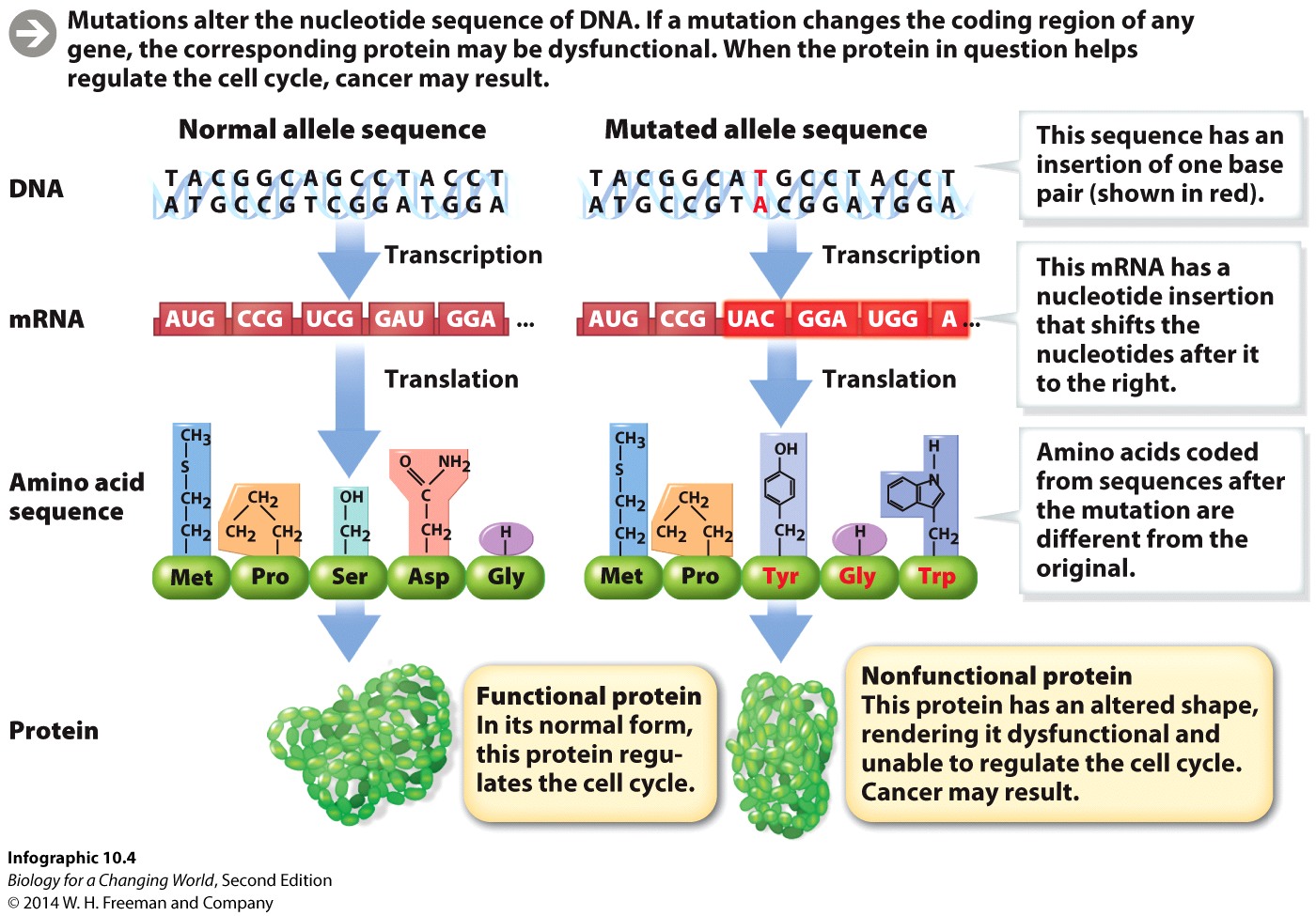
Create your own version of Infographic 10.4 by following these 4 steps:
HoqPdIylEWqTpQN/JckhXRuLSatbJX8bWR7f5NlgmfzTuxCiDpbKe8G73uLjUOFEqYmnqFBvNiwrE+UjTPzPcg==Question 1.15
TcGn3lPi4NJOmJPJAfkCz4i2rjPpzZNiZwxyRKA/YxGyCYmP8klgCxbtcV634Nl4pRLrcIPj1JuKdb7pigigx/N2h/49EzcOm5brIlPTxbg2ug9XcMH67TEpkyHK8BHc15dyKJzcFiJIjTvgk8DKp08YsNc=Question 1.16
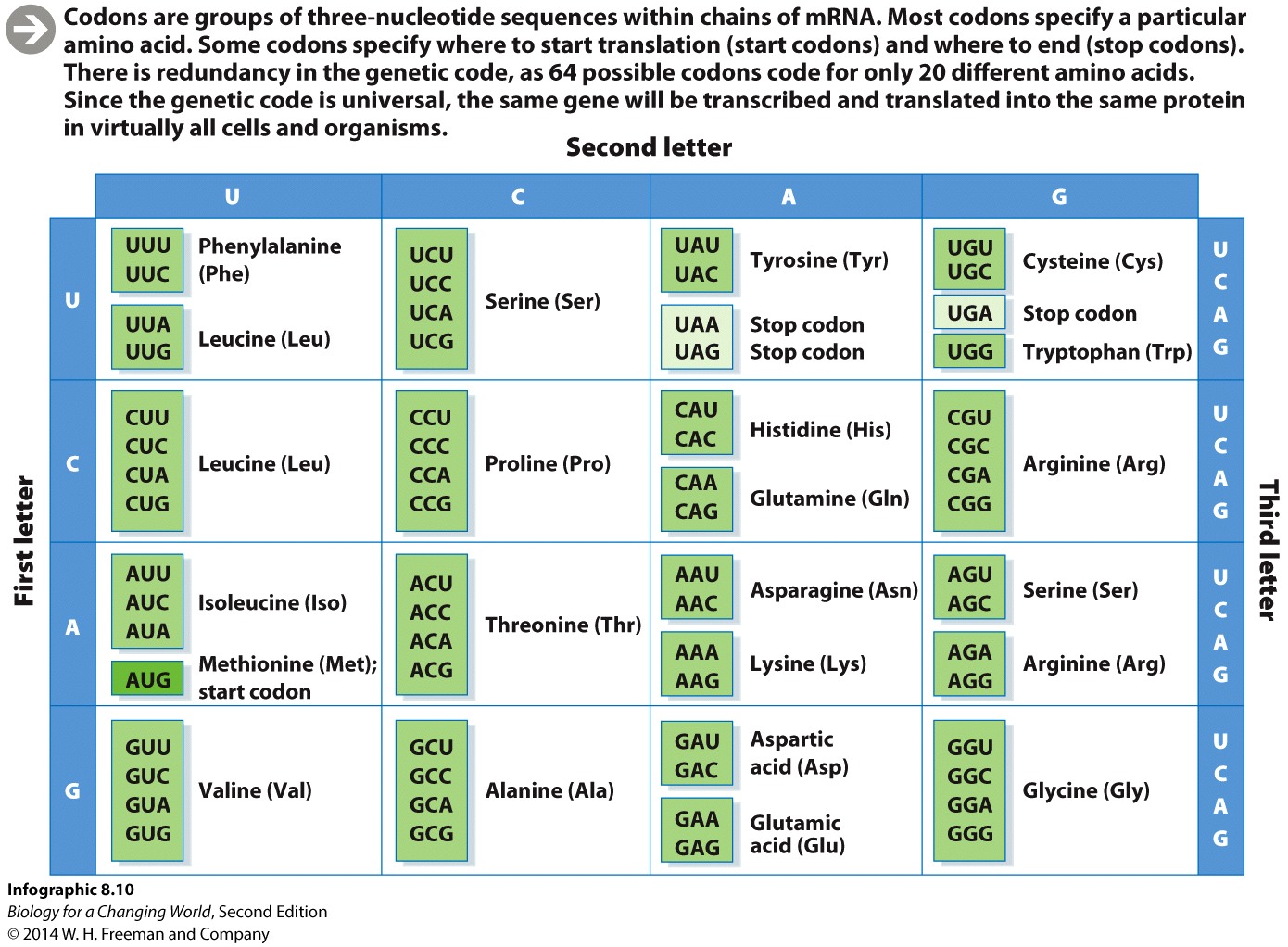
Question 1.17
0+Mx87jjbL1WG23fUp9AHi9LmwXVkAo3hry9JUxmg1p9NukYQH+ZFUxDuDLpHz4iM4swyq4ZfXE=Question 1.18
KrP+rZeL6o5TKIwpPf2KSLmZEBXIs01QUlerjx2qAMpt+hkrhxXTIxOj4BrqZsVRDARok4Ui5Xx7LnD5nNfcvKTxT5rCaTG39Kn5mqz8Av8iAUTGBGj8ApJGGkCWWJ63HZxv3piNLio=Compare and contrast the roles of proto-oncogenes and tumor suppressor genes in regulating the cell cycle.
Question 1.19
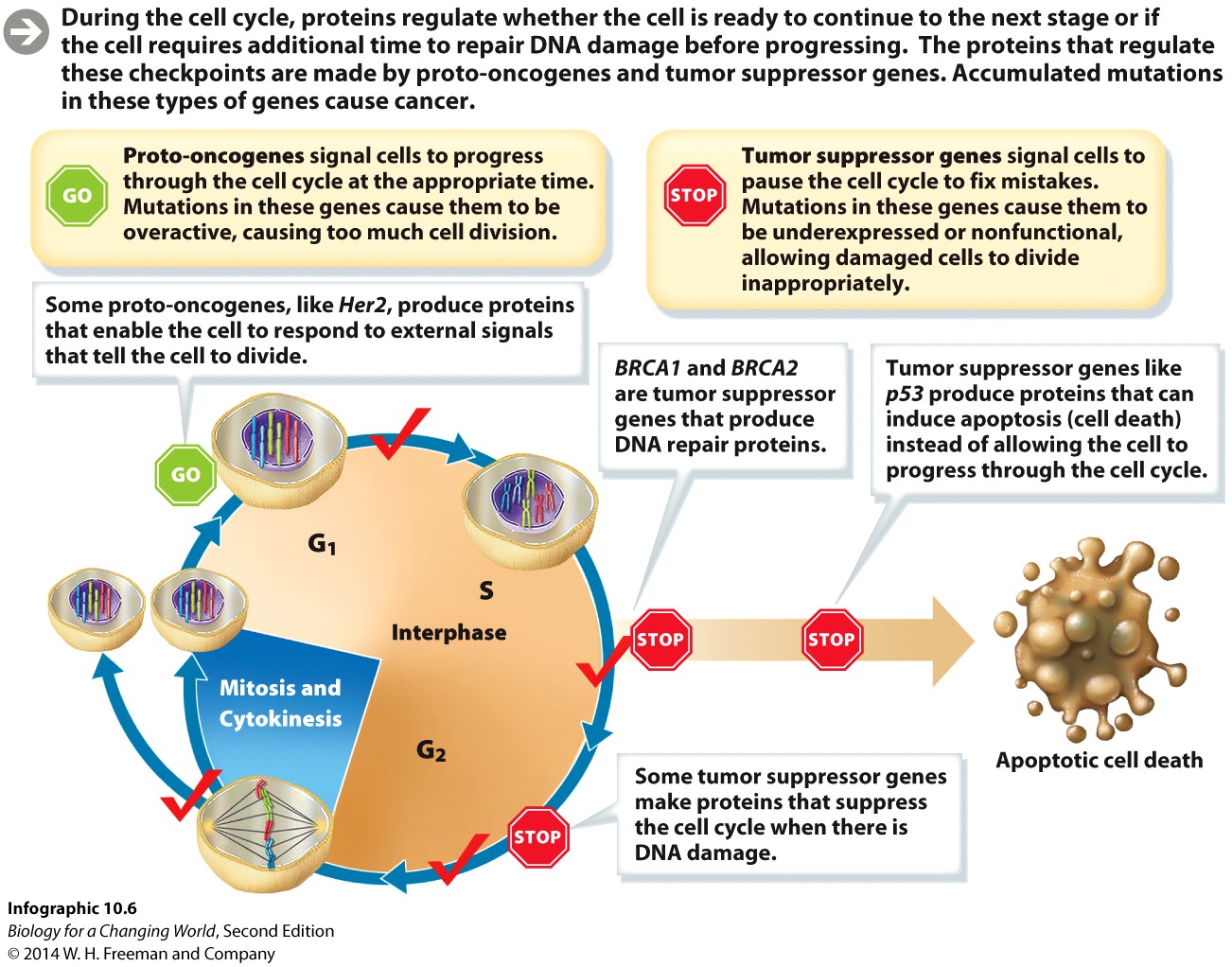
Use Infographic 10.6 to answer the following questions:
nJ2layaH4V/7zN1PaPnSgt5QHl8C3B0+l3Tq2vZcErCyVEQigB8NEp2aZPsoq+bk9Vj3elA8/f7BDRL/ODGFTp+kD2/N7l/JuSY50GB1t8agnXhzWMuvZlHRYBLh9TFv+q090G1vr1pZAAfBa+4cdIuvr944FkiipvoAtAxQEuU=Question 1.20
vpxke9qnaOraRsCckLL2lKolzWyiyA+Ta3ywT4jYerfkcUWgNVYlscZK287wlnC5JfK3uRnjPGWB27JtKCkcgTFCMz5U3v6WQgbKeR3fFoekMlTFApTMs58ieNheeZP9U17AnO+cgnODyUUt0GhAwQ==Question 1.21
kVyz1VQNdjA1Vbuh+78oeqoUnzQtw6rTTi1HM0fxhjC7jst8TE7UCf9WKcH9pYXyksdECCM+kxuONT9QSEqnoLYOh4S5rVA7h1AB0rYS1NzMpvS4xskcdeDHOO3jWqxiuBub7yUDeXSf8bra3/ZdaChVULn260ody03UD3KpmQBmUBSquZJZSCLjt/YLjkoF5rorpKiyOQ9OZgzZTdmTYSJirYO81iC7l3Uodk3ziwUitQxm1eoXlaxJ0k8++X5oExplain how mutations in proto-oncogenes and tumor suppressor genes can increase cancer risk.
Question 1.22
hNazUyE0QKQMrP+br8dyF2U08Di03jh+x7FqvvaIRnwh7BraoJTHk0fK9CI=Question 1.23
Oehx+/KvgMtCL8FBzjkAkoVQEL6naqZ4NGhnN3HJZxZ8oO3Y0d0Fstv4jYzM0mLhbabHODm0CNI=Question 1.24
QtH4bBwAhf0dB5qDZ0BXxt6nnBJmJiVpo+jGzhKqu0VwKT+8FekFavTgNmvXTsPkCjpvS+5Pc3OFLW6knrqalw==List and explain some ways in which people may reduce their cancer risk.
Question 1.25
kF4MACa6TIDF16NQObKNd7YqaqxycSC5OcUpeM/w5MJQDjmA363fBUil92gnN3ccOvD+y4ADM89iamPkXicw1RnOEjg4jSigWT5UNcyvhlg9VkblLOj+7DGzOvzLVu+/cZb/NUBlXPTQAad5HVcWu63HeirEEppSQuestion 1.26
QECExRWcnIljRVYRWDZuwy5ZIqoZLkrycC/LEG3CjA+L/ZuIwRHEE9ws8Bj4JyAl6zMhvsc71mMdGlmqdB/fRAgbDBm5B1wueH32P503J1vRkVsMYds0o3tmpoTuGhGE66geGljNuRN9rVZ78Z3HE2P2YSYFLElEbSevkFmSn0jxLD7QReview Questions
Question 1.27
2d++cyF99/naZ0fvx8OpWuhjP0w//ssb+PQ9+7ecN2fyglp07XzZIiVxPYDMrZLleMOQr0XmcifTsAA4LlBWJOUTH8c/3t1VIlrf4nrCmNq0znr4tQpjyBNpPMXpYK5DoyrtgTFlnLcvfNIR5wAMfOXbuY5qWoPsdNHb4ak49s+ydeoc1kwU5g==Question 1.28
BiRDgvGNBq63Y8mktnrqUi9lbF4s1vn0B2XPhu9lL/kGT3WdxYsgCfJfHzfFyzWvLGvm1JBLlqStqLL4iO7oUQvxudokGJfk1wErSoSKxAfcRyTg3E+9LUGqjEqg0xv/SnPIoGCwfYyYoRYUMiHjtK6bKeyUgdaX4tgz59ZFf+hZQA4Nxqbvk9zHy5h98AlCbTm1PeCBF0birsK50Ini2IW0nXUwVav+B6FlNjnWq6SBgZvR3ZUJzBh7W+cMZ7OJPP/xig==Question 1.29
FvE33/b1HJkIvV6Z/PK5i9nH5cHSbkyoxVCAUx4E8bp18sdoBvMxTBS8ca6p1fsWd3By/neygWN9ZHwpy3ka4zaNeQfS4LuNxbzElwkVBmLUD6etTgaOtZGM9U4BHH69pFAAXQEbbgyS7DmLadv/rLEkV34=1.4 Driving Question 3
Driving Question 3
Why do people with “inherited” cancer often develop cancer at a relatively young age?
Why should you care?
Lorene Ahern’s mutated BRCA1 increases her risk of developing breast cancer. However, it will not cause breast cancer by itself. Cancer cells have many abnormal traits: they divide without normal checks even when crowded, invade nearby tissues, cause new blood vessels to form that supply them with nutrients, and can eventually spread to distant locations in the body. These traits are the products of multiple mutations accumulating over time. For people who inherit high-risk mutations, this time is shorter than normal.
What should you know?
To fully answer this Driving Question, you should be able to:
- Outline the steps involved in a tumor becoming cancerous and explain why more than a single mutation is required.
- Using this model, explain why inherited mutations increase a person’s risk of developing cancer at an earlier age than normal.
Infographic Focus
The infographics most pertinent to the Driving Question are 10.1, 10.5, 10.6, 10.7, and 10.8.
Outline the steps involved in a tumor becoming cancerous and explain why more than a single mutation is required.
Question 1.30
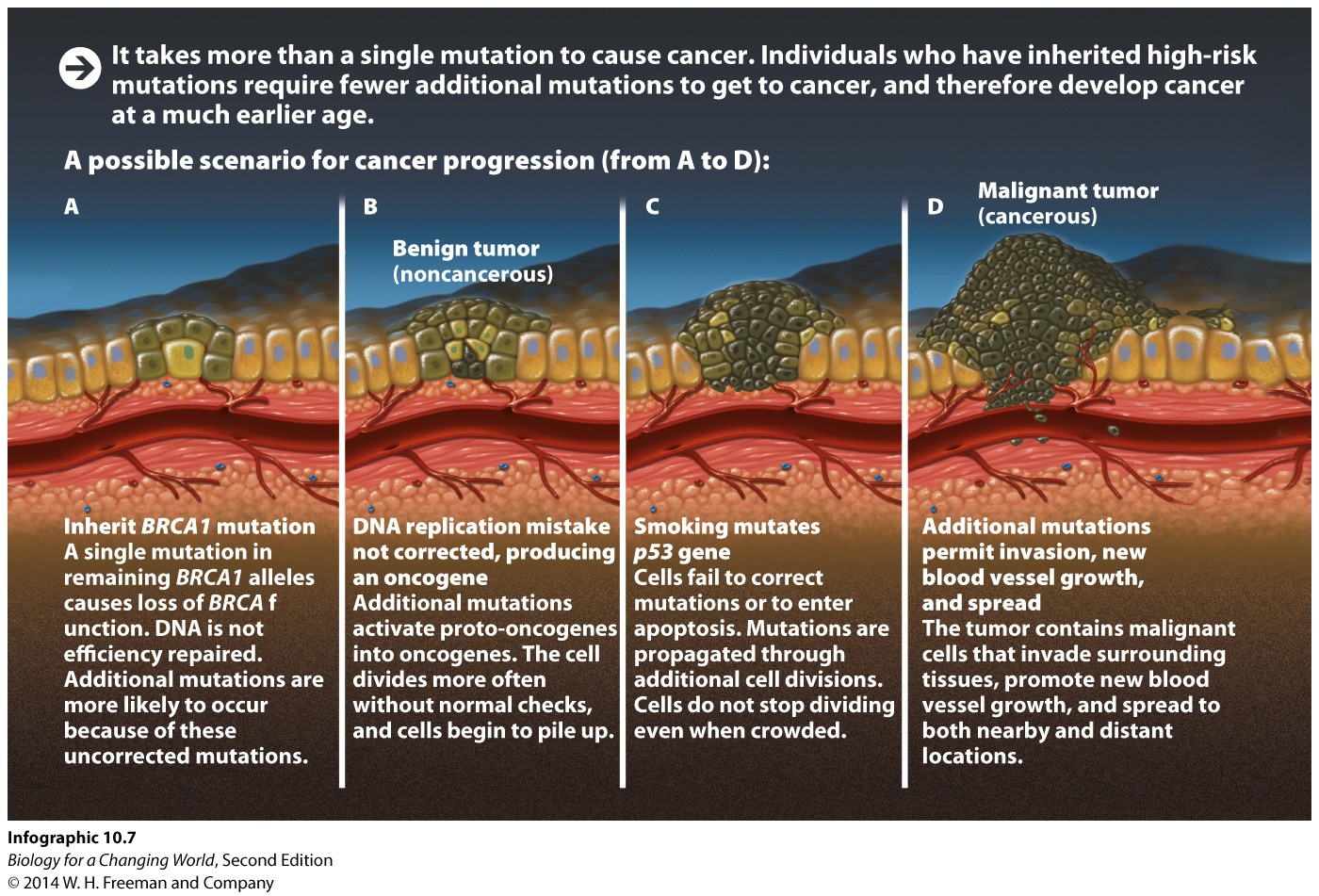
Describe the steps outlined in infographic 10.7 by which a tumor may become cancerous by completing the following table:
| Step A | Step B | Step C | Step D | |
| Describe the mutation |
LU/yM02nlYRE6AmYkP5/HeY78u0=
A single mutation in a tumor suppressor gene associated with DNA repair.
|
LU/yM02nlYRE6AmYkP5/HeY78u0=
The cell is bigger and there is double the amount of organelles.
|
LU/yM02nlYRE6AmYkP5/HeY78u0=
There is only one copy of genomic DNA in the cell.
|
LU/yM02nlYRE6AmYkP5/HeY78u0=
There is only one copy of genomic DNA in the cell.
|
| Describe its consequences |
LU/yM02nlYRE6AmYkP5/HeY78u0=
DNA replicates resulting in chromosome duplication.
|
LU/yM02nlYRE6AmYkP5/HeY78u0=
There is twice as much DNA in the cell.
|
LU/yM02nlYRE6AmYkP5/HeY78u0=
It is pretty similar, but there is less protein synthesis and growth happening.
|
LU/yM02nlYRE6AmYkP5/HeY78u0=
Correct.
|
| Step A | Step B | Step C | Step D | |
| Describe the mutation | A single mutation in a tumor suppressor gene associated with DNA repair. | Additional mutations in proto-oncogenes activate them into oncogenes. | Additional mutations affect tumor suppressor genes associated with apoptosis signaling. | Additional mutations permit tissue invasion, new blood vessel growth, and spread. |
| Describe its consequences | The resulting protein can no longer function normally and DNA mutations are not repaired. Additional mutations begin to pile up. | The cell is continually dividing without stopping for DNA repair. | The mutated cell is not told to self-destruct. Cells continue to divide; the tumor is growing. | The tumor contains malignant cells that invade both nearby and distant tissues. |
Question 1.31
NhGLpwzS7t2I0fJtCs2HQ9d9NecHFtlFdaj305sU7m1K5DinkON7CcWfm/ctP5YaBFnB5CTmdibroBLGFWF+m763DFmrjHe0ub+KaC4Rr6Kp3jUJAMGHydOxXwpuxeINBAp9stTT5tJiAy1X6H5wGpL00YegNwXcGq89OnTGAl1IzXLBV59ZN4LuW4Dzs7BUArEmfAhaw72hqcoNqGhi+g==Using this model, explain why inherited mutations increase a person’s risk of developing cancer at an earlier age than normal.
Question 1.32
PDrl+MGbIXJonC21ZiB9oAlxeJTGGg6mWL7TKLQuSdD/gsqPmmoENTJwo4UsCfHcQKvGMhqbBspZe0utjztSgp/8C8mvf7YkGZGza3qkJa0olJFXaMLluOTxlauPhAODYGA4bBx4sgxTzQU/NXFSWdNpIskzrSUDLjDgeoivqMnJCS/SQuestion 1.33
WtTLzolOfkP8yCfqIlhEoMgh3Kuz+ITKRh/sz9KSYCAM8tKFnlDOUFWSHbpmDwUXhTPvbJUVtpzz61F5mWE9Xy8pMHwLvegPFysi7h0HReCjfSqo3NOBPa9kqPJTPD84qGWcfGRovcMAU/V/SRG62tjfoTLoI4TtIjXa+4uIwrIqHnSlnqn2o6Aes6hTpguVGuplWBeJRImXEpoo4S5iNiEL/2kBh+T+7BdQPa1beDq2pQDskCTTX/j36Xx37jNBJuDD38iE4aspljmLQ33XkDLa1K87Ya4VE6zLHkukgxPLGMY57AJRGY8IFHwcPGsDokgnx4ncDCEEa5GXiPiBaqmPNwudN4I0/d3ybChPIxJcPdqU1JOl8rcfXxS7QA2d2J01mocGFnKMbbAI1OTRfJCBXy4NGqXL/0+k1tcrWqBwlbPGQ0E/z/F7c8rRHABJgeuVDftdC5e6ZMwEFslYrntZbweKa2oQejKT8rDWsdB/RnmxQF2yaA==Review Questions